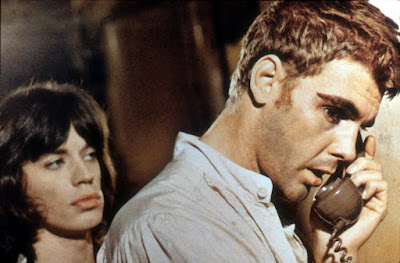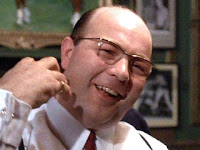 |
| Turner (Mick Jagger), left, keeps watch over Chas (James Fox) in 'Performance' (1970). |
Just another a drug-induced,
decadent, rock ’n’ roll-tinged noir
“Performance” isn’t on many “best neo-noirs” lists — absolutely zero that I could find, honestly. Some might say it shouldn’t be mentioned in the same breath as the 1960s crime films that pay homage to black and white noir classics of the 1940s and ’50s, but allow me to disagree.
The Mick Jagger-co-starring cult film has preoccupations we sometimes find in noir, including the fluidity of, and confusion over, identity. Many a noir anti-hero and heroine develop amnesia or hijack another’s identity, only to learn that posing as the other one can run great risks. In “Performance,” the story is all about a thug’s unexpected search for his identity within the confines of an appropriately shabby mansion in the bohemian part of 1960s London.
The Mick Jagger-co-starring cult film has preoccupations we sometimes find in noir, including the fluidity of, and confusion over, identity. Many a noir anti-hero and heroine develop amnesia or hijack another’s identity, only to learn that posing as the other one can run great risks. In “Performance,” the story is all about a thug’s unexpected search for his identity within the confines of an appropriately shabby mansion in the bohemian part of 1960s London.
The film toggles between a drug-induced hallucinatory tale and a blood-splattered gangster flick. East London mobster Chas (James Fox) elbows his way into the abode of washed-up rock star Turner (Mick Jagger), and it becomes abundantly clear that Chas has crossed the threshold into a world over which he has little understanding and even less control.
 |
| Turner (Mick Jagger) in his lair. |
First Choice: Brando
Aside from the film’s violence, “Performance” is a good deal more exotic in tone and risqué than other crime films of its era. Donald Cammell, who made his directorial debut with “Performance,” originally conceived it as a film about an American gangster hiding out in London. He intended to cast his pal Marlon Brando as Chas, but plans changed and James Fox took the role. Nicolas Roeg, who later directed British supernatural horror classic “Don’t Look Now” (1973), co-directed “Performance,” taking charge of the look of the film. Hardly 'Swinging London'
At its first screening, the film gave movie execs the heebie-jeebies — the paean to “swinging London” they were expecting turned out to be a blunt depiction of sex and drugs that was far more edgy and dangerous than anticipated. Its first reviews were not flattering. One commentator disparagingly observed that it’s as if “Performance” was penned by Mickey Spillane trying to write like Harold Pinter. Upon witnessing the eyebrow raising antics depicted in the film, a Warner Brothers executive’s wife allegedly vomited. Richard Schickel of Life magazine said “Performance” is “the most disgusting, the most completely worthless film I have seen since I began reviewing.”From Woodstock to Altamont
Warner Brothers panicked and shelved the film for a couple of years. Of course, the swinging London era of mods and rockers was hopelessly passe by then and a darker, more decadent atmosphere had taken hold. The counter culture's touchstone event, Woodstock, took place in August of 1969. But so did the Manson Family murders, and four weeks later the Stones organized a free concert at Altamont Speedway in California that saw four fatalities, including the murder of an audience member by Hell's Angels security personnel. “Performance” was already in the can by the time all of these events occurred, and if the film was not exactly prescient, it was at least an indicator of the period of hipster despair and dissolution that was to follow. Of course, Mick and the Stones had earlier recorded and released a hit song, “Sympathy for the Devil” in 1968, an ode to the prince of darkness, himself, so the band’s nod to the demonic was already in plain sight and should have come as no surprise.
As for the fictional Turner, we meet him when he’s experiencing career lag, but his prospects are about to be changed by an unlikely alliance as he and the psychotic Chas cross paths.
 |
| Johnny Shannon as crime boss Harry Flowers |
Flowers the Mobster
It turns out, the brutal mobster routinely squeezes pound notes out of the locals who are unfortunate enough to be caught in crime kingpin Harry Flowers’s (Johnny Shannon) grip. Chas pours acid over one target’s spotless Rolls Royce, smashes things and brutalizes others. He’s a domestic terrorist serving a brutal criminal regime that seems to operate with impunity.Chas eventually falls out of favor with his boss and barely escapes a gangster home invasion with his life. He’s desperately in search of a safe haven, and when he overhears a conversation about a recently vacated basement room he lands on Turner’s doorstep.
Creative Atmosphere
At first he’s not well received but he browbeats the eccentric rocker, claiming he needs to live in a creative atmosphere — he’s a juggler, he maintains. Reluctantly, the singer and his live-in female companions, Pherber (Anita Pallenberg) and Lucy (Michèle Breton), who are the other two-thirds of the singer’s live-in ménage-a-trois, take in the rogue gangster. Turner realizes that Chas possesses something he lacks — a gangster persona, which is an essential element for a rock ‘n’ roll star, you see.
 |
| Identities become fluid in 'Performance.' |
The creative atmosphere — and later, some psychedelic mushrooms — have an effect on Chas. He dyes his hair the color of a bucket of rusty nails, trying to blend in to his new outré sanctuary, and in hopes of evading the gangsters he’s trying to dodge. It’s not a particularly effective disguise, but it’s the first sign of a transformation — and he is one sorely in need of a behavioral transformation.
Fun with Psychedelic Fungus
Earlier in the film we see him having a sadomasochistic encounter with a woman, which fits in with his brutal manner. But after Pherber encourages him to release his psychological demons by exploring the female side of his personality, Chas, fully blitzed on ’shrooms, has a psychological breakthrough as he hallucinates Turner as his crime boss performing the song “Memo from Turner.” It’s classic a moment as neo-noir takes a surreal turn, melding noir with 1960s gender-bending drug culture.
 |
| A gangsters' painting party. |
Godard Connection
Perhaps the film of that era most similar to the chemically induced psychedelia of “Performance” is “Point Blank” (1967), with Lee Marvin as a gangster trying to collect money he is owed. “Point Blank” delves into the hallucinatory, but its surrealistic elements are the product of a dying man’s feverish nightmare rather than hallucinations of the drug-induced variety. It does, however, share a raw, jump-cut induced nervous energy with “Performance,” both of which are kindred spirits with the French New Wave of the 1960s. We see that when an apartment where Chas is doing his dirty work is sprayed and splashed in blood-red paint. The scene is reminiscent of Jean Luc Godard’s color-drenched anarchic “Pierrot le Fou” (1965) — perhaps not so coincidentally, Godard directed a documentary, “The Rolling Stones: Sympathy for the Devil” (1968), the same year that “Performance” was shot. Confusion, double meanings
When “Performance” finally wraps up, we see a thorough blending of identities among the inhabitants of Turner’s decadent pad. The film’s denouement confused the movie executives at its jaw-dropping debut, and, no doubt, many others continue to walk away wondering if they’re missing something. Like “Point Blank,” whose ending is open to interpretation, “Performance” uses noir tropes but also upends them with its elusive, not readily explainable, ending. Mergers, Acquisitions
Turner has apparently merged with Chas, but exactly how did this transformation come about? Don’t strain yourself looking for answers. “Performance” is a mind-bending, occasionally incoherent experience, and you’re welcome to put whatever spin on it you’d like. If you’re curious about that era, this is one film that provides a bracing if somewhat unsettling journey into the past. It may appeal to the nostalgically inclined, those who missed out on the scene entirely, and of course, the ones who were there but, for the life of them, can’t seem to remember any of it — you all know who you are.


No comments:
Post a Comment